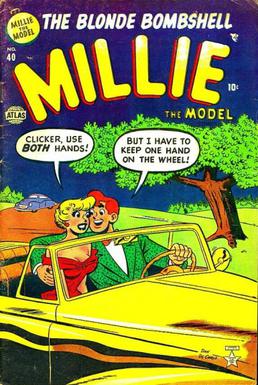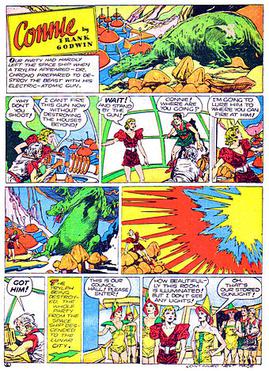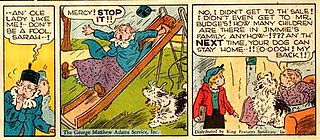The Washington Star, previously known as the Washington Star-News and the Washington Evening Star, was a daily afternoon newspaper published in Washington, D.C., between 1852 and 1981. The Sunday edition was known as the Sunday Star. The paper was renamed several times before becoming Washington Star by the late 1970s.
United Feature Syndicate, Inc. (UFS) is a large American editorial column and comic strip newspaper syndication service based in the United States and established in 1919. Originally part of E. W. Scripps Company, it was part of United Media from 1978 to 2011, and is now a division of Andrews McMeel Syndication. United Features has syndicated many notable comic strips, including Peanuts, Garfield, Li'l Abner, Dilbert, Nancy, and Marmaduke.
Gary G. Dumm is an American comic book artist known particularly for his work illustrating the comics of Harvey Pekar.

Millie the Model is Marvel Comics' longest-running humor title, first published by the company's 1940s predecessor, Timely Comics, and continuing through its 1950s forerunner, Atlas Comics, to 1970s Marvel. The comic book series deals with Millie Collins, an aspiring model working for the Hanover Modeling Agency.

Lady Luck is an American comic-strip and comic-book crime fighter and adventuress created and designed in 1940 by Will Eisner with artist Chuck Mazoujian. She starred in a namesake, four-page weekly feature published in a Sunday newspaper comics insert colloquially called "The Spirit Section", which ran from June 2, 1940, to November 3, 1946. Her adventures were reprinted in comic books published by Quality Comics. A revamped version of the character debuted in 2013 in DC Comics's Phantom Stranger comic.

Frances Edwina Dumm was a writer-artist who drew the comic strip Cap Stubbs and Tippie for nearly five decades; she is also notable as America's first full-time female editorial cartoonist. She used her middle name for the signature on her comic strip, signed simply Edwina.
Kin Platt was an American writer, artist, painter, sculptor, caricaturist, and comics artist, best known for penning radio comedy and animated TV series, as well as children's mystery novels, one of which earned him the Mystery Writers of America Edgar Award.

Crestwood Publications, also known as Feature Publications, was a magazine publisher that also published comic books from the 1940s through the 1960s. Its title Prize Comics contained what is considered the first ongoing horror comic-book feature, Dick Briefer's "Frankenstein". Crestwood is best known for its Prize Group imprint, published in the late 1940s to mid-1950s through packagers Joe Simon and Jack Kirby, who created such historically prominent titles as the horror comic Black Magic, the creator-owned superhero satire Fighting American, and the first romance comic title, Young Romance.

Reg'lar Fellers is a long-running newspaper comic strip adapted into a feature film, a radio series on the NBC Red Network, and two animated cartoons. Created by Gene Byrnes (1889–1974), the comic strip offered a humorous look at a gang of suburban children. Syndicated from 1917 to January 18, 1949, Byrnes' strip was collected into several books. Branding also extended to such items as baseball bats and breakfast cereal.

Nemo, the Classic Comics Library was a magazine devoted to the history and creators of vintage comic strips. Created by comics historian Rick Marschall, it was published between 1983 and 1990 by Fantagraphics.
This is a timeline of significant events in comics in the 1910s.

Connie is an American adventure comic strip created by the cartoonist Frank Godwin, who introduced a book illustration style to the comics page. The strip ran from 1927 to 1941 for the Ledger Syndicate. Connie debuted as a Sunday page on November 13, 1927. The strip was syndicated in France as Cora in the weekly paper Le Journal de Mickey.

Cap Stubbs and Tippie is a syndicated newspaper comic strip created by the cartoonist Edwina Dumm that ran for 48 years, from August 21, 1918, to September 3, 1966. At times the title changed to Tippie & Cap Stubbs or Tippie.
George Matthew Adams was an American newspaper columnist and founder of the George Matthew Adams Newspaper Service, which syndicated comic strips and columns to newspapers for five decades. His own writings were circulated widely to The Gettysburg Times and many other newspapers.
The Bell Syndicate, launched in 1916 by editor-publisher John Neville Wheeler, was an American syndicate that distributed columns, fiction, feature articles and comic strips to newspapers for decades. It was located in New York City at 247 West 43rd Street and later at 229 West 43rd Street. It also reprinted comic strips in book form.

Half Hitch is an American comic strip by Hank Ketcham, in syndication first between 1943 and 1945 and later from 1970 to 1975. It is an example of military humor, but unlike most cartoons and comics of this genre, is focused on the navy, rather than the army. The unnamed character first appeared in The Saturday Evening Post in 1943.
Although, traditionally, female comics creators have long been a minority in the industry, they have made a notable impact since the very beginning, and more and more female artists are getting recognition along with the maturing of the medium. Women creators have worked in every genre, from superheroes to romance, westerns to war, crime to horror.
Larry S. Todd is an American illustrator and cartoonist, best known for Dr. Atomic and his other work in underground comix, often with a science fiction bent.
Notable events of 1931 in comics.
Maurice Horn was a French-American comics historian, author, and editor, considered to be one of the first serious academics to study comics. He was the editor of The World Encyclopedia of Comics, The World Encyclopedia of Cartoons, and 100 Years of American Newspaper Comics. Born in France, he was based in New York City. Horn died on December 30, 2022, at the age of 91.









